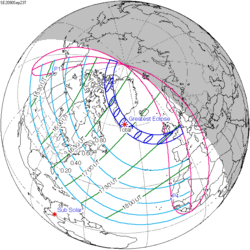| Total eclipse | |
 | |
| Gamma | 0.4987 |
|---|---|
| Magnitude | 1.028 |
| Maximum eclipse | |
| Duration | 156 s (2 min 36 s) |
| Coordinates | 11°06′N67°42′W / 11.1°N 67.7°W |
| Max. width of band | 108 km (67 mi) |
| Times (UTC) | |
| Greatest eclipse | 16:00:21 |
| References | |
| Saros | 139 (24 of 71) |
| Catalog # (SE5000) | 9317 |
A total solar eclipse occurred at the Moon's ascending node of orbit on Thursday, February 3, 1916, [1] [2] [3] [4] [5] [6] [7] [8] with a magnitude of 1.028. A solar eclipse occurs when the Moon passes between Earth and the Sun, thereby totally or partly obscuring the image of the Sun for a viewer on Earth. A total solar eclipse occurs when the Moon's apparent diameter is larger than the Sun's, blocking all direct sunlight, turning day into darkness. Totality occurs in a narrow path across Earth's surface, with the partial solar eclipse visible over a surrounding region thousands of kilometres wide. Occurring 1.7 days after perigee (on February 2, 1916, at 0:00 UTC), the Moon's apparent diameter was larger. [9]
Contents
- Observations
- Eclipse details
- Eclipse season
- Related eclipses
- Eclipses in 1916
- Metonic
- Tzolkinex
- Half-Saros
- Tritos
- Solar Saros 139
- Inex
- Triad
- Solar eclipse of 1913–1917
- Saros 139
- Metonic series
- Tritos series
- Inex series
- Notes
- References
Totality was visible in Colombia, Venezuela, and the whole Guadeloupe except Marie-Galante, Saint Martin and Saint Barthélemy. A partial eclipse was visible for parts of North America, Central America, northern South America, Northwest Africa, and Western Europe.



































































































